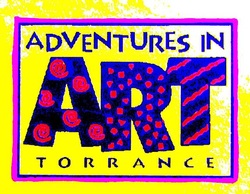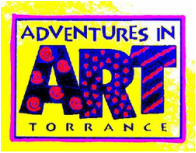Philosophy and Goals
The philosophy of Adventures In Art emphasizes problem solving that allows the child to determine the desired end result.
The Adventures In Art experience for children should:
• Exercise their powers of observation and imagination
• Stimulate their motivation to learn
• Encourage them to make choices
• Inspire them to be flexible and to adapt
• Show them how to go from an unknown to a known
Adventures In Art draws children into their subject matter rather than just telling them about it. Children have the freedom to touch, handle, and experiment with various art materials and techniques. They are encouraged to look, to ask questions and to find their own truths. This approach fosters self-esteem and the understanding and acceptance of our differences.
Adventures In Art Docents follow these guidelines to give validity and spirit to the children’s art experience:
• Do not judge or grade the child’s artwork in any way.
• Do not write or draw in any way upon a child’s art project.
• Remember, nothing is a mistake…encourage a child to look from a different perspective at what he/she considers a mistake.
• Allow for involvement and experimentation with materials. Materials often provide sufficient motivation, and experimentation often leads to discovery.
• Encourage individual differences and do not over-acknowledge a child’s work. Too much attention will cause self-consciousness and the work you are praising may be imitated.
• Not all projects will be successful with each child or with each class.
• Be flexible; anxiety and frustration are often preludes to creativity.
• Some children want to be left alone in the process of creating. For those that do not want to participate in the project, do not force them to.
• Allow for questions.
Above all, honor the child.
The Adventures In Art experience for children should:
• Exercise their powers of observation and imagination
• Stimulate their motivation to learn
• Encourage them to make choices
• Inspire them to be flexible and to adapt
• Show them how to go from an unknown to a known
Adventures In Art draws children into their subject matter rather than just telling them about it. Children have the freedom to touch, handle, and experiment with various art materials and techniques. They are encouraged to look, to ask questions and to find their own truths. This approach fosters self-esteem and the understanding and acceptance of our differences.
Adventures In Art Docents follow these guidelines to give validity and spirit to the children’s art experience:
• Do not judge or grade the child’s artwork in any way.
• Do not write or draw in any way upon a child’s art project.
• Remember, nothing is a mistake…encourage a child to look from a different perspective at what he/she considers a mistake.
• Allow for involvement and experimentation with materials. Materials often provide sufficient motivation, and experimentation often leads to discovery.
• Encourage individual differences and do not over-acknowledge a child’s work. Too much attention will cause self-consciousness and the work you are praising may be imitated.
• Not all projects will be successful with each child or with each class.
• Be flexible; anxiety and frustration are often preludes to creativity.
• Some children want to be left alone in the process of creating. For those that do not want to participate in the project, do not force them to.
• Allow for questions.
Above all, honor the child.


